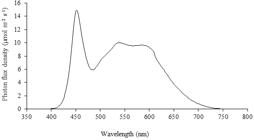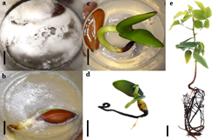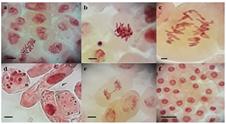ABSTRACT
The development of tissue cultured-based protocols applied to braúna, an endangeres species, would be though highly desirable. However, contamination-free explants are determinant for the success of this technique, which might be vulnerable to the toxicity of disinfectants. Here, we aimed at establishing an efficient protocol for in vitro production of axenic seedlings of braúna and to evaluate the toxicity of disinfectant agents in the Lactuca sativa model species. Experiments I and II: Seeds were treated with sodium hypochlorite (NaOCl) and fungicide captan, with and without residue, by different immersion times, respectively. The following were analyzed: contamination; germination and normal and abnormal seedlings. Experiment III: Lettuce seeds placed in Petri dishes were exposed to 2.5 mL captan at 0.5; 1; 2; 4 and 8%; 0.01% glyphosate and distilled water. The germination, length of seedlings, cell cycle, nuclear and chromosomal alterations of the cells of the root meristem were assesed. The isolated use of NaOCl was not efficient in the disinfestation of braúna seeds. However, the immersion of the seeds in captan, for 10 minutes with its residue, led to higher germination and vigor indexes; however, resulted in the formation of abnormal seedlings. This compound exhibited toxicity in the lettuce model seeds because affected the germination and the whole development of the seedlings, showing clastogenic and aneugenic action in the meristematic cell cycle.
Keywords:
Abnormal seedlings; Disinfestation; Melanoxylon braun; Plant tissue culture; Seeds

 Thumbnail
Thumbnail
 Thumbnail
Thumbnail
 Thumbnail
Thumbnail
 Thumbnail
Thumbnail



